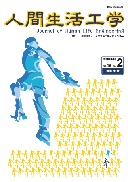All issues

Volume 7 (2006)
- Issue 4 Pages 34-
- Issue 3 Pages 25-
- Issue 2 Pages 31-
Volume 7, Issue 3
Displaying 1-2 of 2 articles from this issue
- |<
- <
- 1
- >
- >|
-
Takeyoshi Kaminishizono, Tatsuya Morii , Teiyuu Kimura, Naozumi Orii2006 Volume 7 Issue 3 Pages 25-29
Published: 2006
Released on J-STAGE: May 21, 2021
MAGAZINE FREE ACCESSWe have developed a bedroom for high-quality sleep as part of a house of dreams named PAPI produced by TOYOTA. In this house the ubiquitous network is adapted for the control of bedroom environment in order to optimize the quality of sleep over all the sleeping stages. Especially, the natural and comfortable wake-up at the desired moment is achieved by using the combination of a biosensor, artificial lighting apparatus and blind-shutters. The realized system detail as part of the project will be described in this article.View full abstractDownload PDF (2481K) -
Masayuki Mochita, Chihiro Kobayashi, Minoru Sato, Yumiko Katsukawa ...2006 Volume 7 Issue 3 Pages 30-35
Published: 2006
Released on J-STAGE: May 21, 2021
MAGAZINE FREE ACCESSThe aim of this study was to develop a new braking system for a kitchen stool with casters to prevent unexpected backward movement as the user sat down on the stool. First, the cause of the backward movement was analyzed by observing subjects using the stool. The cause was identified as a horizontal load incurred at the initial stage of being seated. Based on those findings, we designed a new caster with a built-in brake, which was on/off controlled by the vertical load. The brakes were activated only while the subject performed the sitting–down motion and released once the subject's weight was completely placed on the stool. Additionally, the load distribution on five casters during the sitting motion was calculated to determine the exact load required to release the brakes. As a result of those studies, we were able to achieve stability of the stool during the sitting motion while maintaining the ease of movement once the user was seated.View full abstractDownload PDF (3553K)
- |<
- <
- 1
- >
- >|